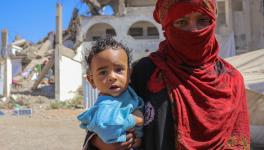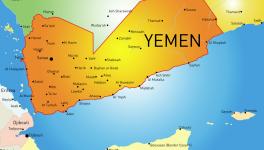UK Arms Sales to Saudi Arabia Face High Court Challenge

At least 60 people killed in a Saudi-led airstrike in southwestern Yemen, September 2019. (Photo: Felton Davis via Flickr)
On Tuesday, January 31, the High Court of Justice in London initiated a judicial review of the UK government’s arms sales to Saudi Arabia, even as the kingdom continues to lead an international coalition that has waged a war on Yemen for the past eight years.
Over the course of three days, the court will hear a challenge brought by the Campaign Against Arms Trade (CAAT) against a decision taken by former Secretary of State for International Trade Liz Truss to resume arms sales to Saudi Arabia in July 2020.
The UK is the second largest arms supplier in the world, after the US.
In June 2019, the UK Court of Appeal had ruled in favor of a previous legal challenge by the CAAT, declaring that the government’s licensing grants for arms sales to Saudi Arabia were “irrational and therefore unlawful” in the absence of a proper assessment of whether Riyadh had a record of violating international humanitarian law (IHL), or the “laws of war,” in Yemen.
The UK’s laws stipulate that an arms sale must not proceed if there is a “clear risk” that a weapon “might” be used in a serious violation of IHL.
While the court’s decision forced the UK to suspend sales, the move was undone a year later when Truss concluded that any possible violations of IHL committed by Saudi Arabia were “isolated incidents” not constituting a pattern.
‘Patterns of harm’
According to the Yemen Data Project, the Saudi-led coalition has carried out over 25,000 air raids on Yemen since 2015, killing 8,983 civilians and injuring 10,243 others. The coalition has also repeatedly targeted critical civilian infrastructure including hospitals, schools, dams, and schools—which is a violation of international law.
According to the CAAT, over half of Saudi Arabia’s combat aircraft used in these air raids are supplied by the UK. The government has also admitted to the deployment and use of UK-made equipment in Yemen, including Typhoon and Tornado aircraft, Paveway bombs, and Brimstone and Storm Shadow missiles.
Researchers and weapons experts have also identified UK-made munitions at the sites of several coalition bombing attacks, including at a community college in the village of Kouhaza in Sana’a in 2016.
The legal challenge brought by the CAAT has been supported by key interventions made by leading international advocacy organizations including Oxfam, which has in the past exposed “patterns of harm to civilians.” In a report released earlier this month, Oxfam found that between January 2021 and February 2022, air strikes by the Saudi-led coalition were responsible for killing at least 87 civilians and injuring 136.
There were 19 attacks on hospitals, clinics, and ambulances, and 293 attacks that forced people to flee their homes. Of the 1,700 attacks on civilians analyzed in the report, 25% were air raids by the Saudi-led coalition using weapons solely supplied by the US and the UK.
Mere months before Truss announced the resumption of arms sales in 2020, 34 civilians were killed and another 19 were injured in airstrikes on Al Hayjah, located in the Al Jawf governorate. A majority of the casualties were children.
Weapons pour in
The CAAT has led a protracted legal effort to end UK arms sales to Riyadh since 2016. While the published value of the licensed arms exports from the UK to the Saudi-led coalition since March 2015 stands at around $11.5 billion, the CAAT has estimated that the real value of exports actually stands at over $30 billion, with more than $28 billion worth of arms going to Saudi Arabia alone.
Little changed during the official truce period between April and September 2022. Data for military and dual-use (which refers to materials which are of either military or civilian use) export licenses issued between April and June released by the UK Department for International Trade showed that single licenses for military exports issued to Saudi Arabia were valued at $918 million, the majority of which were for “components for bombs.”
Soon after the ban on arms sales was lifted in 2020, CAAT had filed an application for a judicial review to determine the legality of the government’s decision, arguing that Truss’ approach was unlawful on the grounds that she had “failed to identify all of the cases where there has been a serious breach of IHL,” that she had “wrongly concluded” that there was no pattern to these violations, “misdirected herself as to the nature of a serious breach of IHL,” as well as failed to account for Saudi Arabia’s own failure to “investigate, prevent, or punish” serious breaches.
The plea also highlighted the findings of various UN bodies that had concluded that Riyadh had indeed committed repeated IHL violations, including indiscriminate targeting, repeated failures to distinguish between civilians and combatants, and attacks which “[resulted] in disproportionate death or injury to civilians, absent any identifiable military target.”
That same year, the UN Group of Eminent International and Regional Experts on Yemen had published a report warning that IHL violations in Yemen may amount to war crimes. Among the recommendations made by the group was that the case be referred to the International Criminal Court (ICC). A year later, the UN Human Rights Council voted to end the investigation’s mandate, amid reports of pressure from Saudi Arabia.
Meanwhile, in April 2021, the UK High Court granted permission for the CAAT to proceed with its legal challenge.
As the hearing proceeds this week, it is also important to note that civilian casualties caused by direct military attacks reveal only a limited part of the war that has been waged on Yemen. The armed campaign has been accompanied by a crushing land, air, and sea blockade and a sanctions regime that has collapsed Yemen’s import-dependent economy, and caused a humanitarian catastrophe that was already estimated to have killed over 377,000 people by 2021.
Over 70% of the country’s population, or around 23.4 million people, are in need of assistance, with 4.5 million people still displaced from their homes. Between October and December 2022, an estimated 17 million people were facing crisis or worse levels of acute food insecurity.
Reports of back channel talks between the Houthis and Saudi Arabia have raised some expectation that the ongoing truce might be extended, especially in the absence of major fighting in the past months. However, incidents of fresh violations by the coalition have continued to be reported.
Get the latest reports & analysis with people's perspective on Protests, movements & deep analytical videos, discussions of the current affairs in your Telegram app. Subscribe to NewsClick's Telegram channel & get Real-Time updates on stories, as they get published on our website.
























